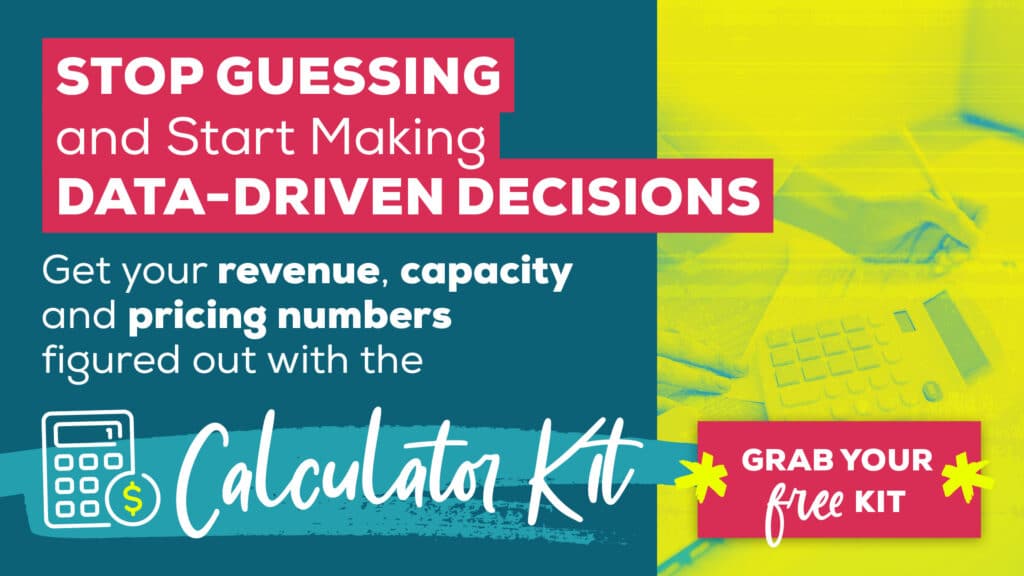
Search the site:
Making the Math “Math” for Your Service Business
One of the worst pieces of advice I ever received about my business was related to my financials. And frankly, it’s the type of advice that’s in heavy rotation in the online business world, and it screws up people’s businesses in a big way.
The impact of that advice leaves far too many service business owners unable to pay themselves the way they should. They’re often making plenty of money, but how they’re being taught to manage and spend it is to their detriment.
And that needs to stop. In this episode, I’m kicking off a new series about the numbers you need to know in your business, starting with a fresh look at your financials so your math adds up and gets you paid.
Yes, we’re talking about revenue, expenses, profit and how to make that work so you get paid like your professional and can grow sustainably.
A fun fact about me is that numbers don’t come naturally to me, and it’s an entire skill set I’ve had to learn over the years. And I know that’s the same for many of you.
You may feel uncomfortable, overwhelmed, or even worried you’ll get it wrong. After all, you probably started a business because you’re good at your craft, not because you love everything that goes with running a business or the numbers.
If you struggle to make the math work in your business, or you’ve been derailed by BS financial advice from celebrity entrepreneurs who don’t even run a service business, this episode will give you a new perspective on the numbers game regarding your money.
I wanted to do this episode because whether you love or hate the numbers, your business’ numbers, especially its financials, provide critical data to make good decisions. Because we all know what happens when the math isn’t correct….it’s tough to make sound choices and run a sustainable business.
This episode aims to help you get to know your numbers a little more and become comfortable with using them as a strategic tool in your business rather than an annoying thing you have to deal with. By the end of the episode, you’ll have one or two really practical things to go away and implement in your business related to your financials.
A quick disclaimer: I’m not a bookkeeper, accountant, or any type of financial professional, and it’s not my intention to play one here on this podcast. I encourage you to treat what I share in this episode as a starting point and ALWAYS consult a qualified professional for advice specific to your situation and local requirements.
Decoding the Dollars: Revenue Numbers
Let’s start by exploring the big kahuna of numbers in your business, your revenue number. Yes, I know, the one everyone on the internet loves to flaunt as proof of their success because revenue is the only metric that matters, right?
If only it were that simple!
Yes, you need to know how much money you make monthly and yearly at the highest level. But there’s a little more to it than that, as you can use those numbers to help make decisions related to your marketing, sales, and capacity planning.
Look for trends related to the following:
- Where do you have monthly or seasonal highs and lows?
- Is your revenue growing, or is it flat?
- What’s your month-over-month and year-over-year revenue increase or decline?
But what do you do with that information? Here are a few examples:
- If you have a seasonal low in Q4, you can ramp up marketing to get ahead of that lull.
- If your revenue is growing, you can look at why that is the case and double down on what’s driving sales and new revenue.
- If your revenue is flatlining or declining, that can be a symptom of not having the right marketing in place, needing to increase your pricing or something not working in your sales process.
Typically, we look back at our revenue to predict these trends, but I recommend proactively forecasting revenue for the coming months. By projecting your income based on reality (not wishful thinking), you can see where you may need more marketing or business development, predict capacity, and make spending decisions.
If you need help with your revenue projections, you’ll want to check out the calculator I’ve created in our new Calculator Kit.
Remember, focusing solely on top-line revenue can be misleading, as it represents only one aspect of your financial health. Think of the last time you saw someone claiming they made seven figures in a social media post. Sure, they had a million dollars in revenue, but it doesn’t tell you how much money they’re spending or keeping.
This is the perfect example of why income claim marketing is such BS and why revenue is only part of the picture.
You need to consider the entirety of your financial metrics to avoid being deceived into believing your performance is more robust than it is.
Expenses and Budgeting: Where Does Your Really Money Go?
It’s easy to get caught up in chasing a revenue number, but how we manage our expenses is just as, if not more important, to running a sustainable business.
Too many business owners get sucked into the idea that they must “invest” to grow their business and find themselves overextended and in debt. Constantly overspending creates needless stress and pressure in your business.
Remember that “bad” advice I mentioned at the start of the episode? I have a confession. Once upon a time, a coach I worked with encouraged me to rack up some debt to “invest” in Facebook ads. How they explained it made it sound reasonable and like it was a sure thing.
Narrator voice: It was not a sure thing. It was an unmitigated disaster.
It was a tough lesson, especially since I had to pay off that debt for the next year. So much time, energy, and money was dumped into this slot machine marketing strategy that’s complete and utter hot garbage.
Enter why I won’t ever stop telling anyone and everyone that they need a business budget. Let me tell you, that mistake taught me not to go into debt for this kind of bullshit as an “investment” and not to spend money I don’t have.
TL:DR: Learn from me. Don’t be sucked in by this type of magical thinking, and stick to the budget.
If you don’t have a business budget or haven’t looked at yours lately, now’s the time to revisit it.
You need to know exactly what it costs to run your business and keep a firm eye on your spending to save you a major headache later. The budget is a tool to proactively manage your business versus just winging it and looking at expenses afterward. (Or, you know, spending money you don’t have.)
Best of all, your budget doesn’t need to be fancy. Notebook, spreadsheet, program, I don’t care. You just need to capture all your expenses in a single place so you know how much everything costs you.
Remember to take the time to include easily missed things like tools with an annual subscription or those random low-cost courses you buy. The goal is to capture all the info so you don’t have surprises.
For example, I know how much a podcast episode costs me to produce and my monthly tool expenses. This information helps me make decisions in my business and ensure that I’m not overspending. If I buy anything, I look at the budget and decide if this is what I want to spend my money on.
Having and managing a budget should be a minimum in your business, the same way you need to know your revenue. If you’re uncomfortable with these numbers, trust me when I say it gets easier with time.
Remember, this is a skill you can develop over time, and hiring help is okay! Don’t worry about being judged; accountants and bookkeepers have seen it all and are concerned about the numbers. They’re not sitting around wondering why you bought another course or how many sticky notes, notebooks and rainbow markers you need.
The Path to Profit
Now, on to a much more exciting number: your profit. I’m serious. Get excited about this one, as it can tell you so much about what’s happening in your business that you may not even notice.
As a reminder, profit is the total revenue after deducting all expenses, including taxes. Your profit margin is that number expressed as a percentage.
Here is a quick rundown on what this looks like:
- Revenue – $50,000
- Expenses $25,000
- Profit – $25,000
- Profit Margin – 50%
This is a great profit margin, and don’t worry if you’re nowhere near that, I used these numbers because the math was easy to follow.
When you look at your profit margin, you start to see where:
- You may be undercharging and need to adjust your pricing.
- Where do you need to pay yourself more or pay yourself a bonus?
- Opportunities for adjusting your budget.
I know exactly what your next question is: What’s a good profit margin?
The short answer is that it’s complicated, as many factors come into play. I would encourage you to nail down your current profit margin and assess how to improve it.
The two biggest reasons I see low-profit margins for service business owners are overinvesting in coaching and courses and underpricing their offers. Knowing your profit numbers is important, as you can quickly see where you need to adjust your business to ensure you can pay yourself.
You Need to Get Paid Like a Professional
A hill I will gladly die on is that every service business owner needs to be able to pay themselves a salary.
I know I’ve been ranting this episode about bad advice (as usual), but this constant “you need to invest in your business” message that celebrity entrepreneurs push has messed up many people. They spend so much money on all the things that are supposed to help them grow (and usually don’t) that they aren’t able to pay themselves.
It pisses me off. And I’m on a mission to stop people from paying everyone but themselves and counter the idea that you must spend your way to success.
When you constantly make these BS “investments” in your business, you’re setting yourself up to get stuck in a loop of having to earn more and more to pay for them. So before you make any spending decisions, assess what you expect to get out of it and whether the potential benefit is greater than the cost.
But what if it’s not the investments you’re making?
Real Talk: You may be in a season where business is slower, as many people are, and that’s okay. The key is managing accordingly and not creating a situation where your expenses exceed your revenue and you can’t pay yourself.
Finally, pricing and capacity are big contributors to paying yourself, so we’ll tackle those in upcoming episodes.
In the Staying Solo Framework, salary is one of the six pillars. If you’re constantly underpaid, it’s hard to feel good about your business and show up to serve your clients. It’s way too easy to feel resentful and overwhelmed by your work as you can’t adequately meet your personal needs.
Many service business owners decide on their salary by looking at their revenue, subtracting expenses, and then deciding they get the leftovers. You need to get paid like a professional, and that’s not just getting the leftovers after everyone else gets their piece of the pie.
Instead, I want you to have a salary number that goes into your budget and factors into all of your other spending choices.
That number may vary over time, but I encourage you to do the math to determine your target salary goal based on your needs and the revenue you need to make based on your expenses and taxes.
A good example is if you want to earn $6,500 a month but have $1,850 in expenses and 25% taxes, you’ll need to make $9,975 monthly.
To help you with this, I’ve created the Reverse Salary Calculator in the Calculator Kit.
Once you play with those numbers, you’ll see if you need to increase revenue, decrease expenses, etc.
Deep breath. If your desired salary goal isn’t what you’re making today, this gives you valuable information for planning and setting goals in your business.
Take the example of wanting a take-home of $6,500 per month, but right now, it’s more like $4,000, which gives you something to work towards. You can look at your pricing, budget and so on to maneuver the numbers over time.
It is doable, but you need to start where you are and make the math work for you.
Take Action: Do a 15-Minute Financial Review
To wrap up this episode, I challenge you to take 15 minutes this week and quickly peek at your revenue, expenses and profit for the first few months of 2024 and ask the following questions:
- What patterns do I see with my revenue?
- How am I doing with my budget and expenses?
- What’s my profit margin and what is it telling me?
- Do I have a firm handle on my salary goal?
Even 15 minutes with a cup of tea or glass of sparkling water can help you identify potential opportunities for the rest of the year. What matters here is that you take the time to do it and get curious (and not judgy) about what the numbers tell you.
Your numbers will give you data to make decisions based on facts, not just feelings, which can go a long way in helping you make decisions for your business.


I’m Maggie Patterson (she/her), and services businesses are my business.
I have 20+ years of experience with client services, am a consultant for agency owners, creatives, and consultants, and vocal advocate for humane business practices rooted in empathy, respect, and trust.
Read or Listen to the Latest
For Solo Business Owners

Growing a solo service business is tough.
It’s even harder when you’re bombarded with BS advice that steers you away from your values and why you started your business in the first place.
This is the podcast for solo creatives and consultants who want to remain as a team of one and have zero interest in the hustle and grind of typical business teachings.
Subscribe now and never miss an episode.
For Micro Agency Owners
Most podcasts for agency owners obsess over revenue growth as the ultimate success metric.

But here’s the truth: not everyone wants to make millions. Your goal might be to build a sustainable business that lets you have a life and doesn’t run you into the ground.
Join me as I spill my shameless confessions and share everything I’ve learned about building a micro agency that skips the BS of tired and typical agency teachings.
Follow Now on All Major Podcast Platforms








